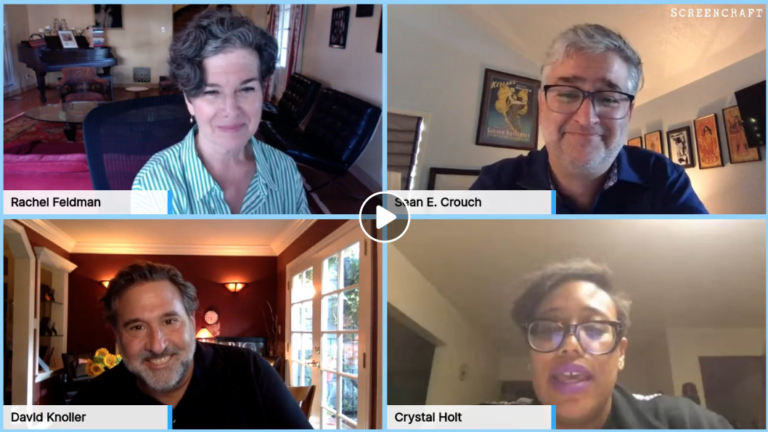How to Write TV Bibles & Treatments: 8 Tips from the Pros

In preparation for ScreenCraft’s upcoming TV Pilot competition, we gathered four top TV industry pros together for a live stream jam-packed with vital information on how to write TV bibles, how to pitch your pilot on Zoom, what you need for a great lookbook, and all the other writing and peripheral documents you need for your pilot script.
Hosted by 2019 ScreenCraft TV Pilot winner, Rachel Feldman, join these expert panelists for literally everything you ever wanted to know about how to write a TV bible:
- Crystal Holt - Director of Development & Scripted Programming at (AMC Networks)
- Sean E. Crouch - TV Writer, Creator, and Showrunner (Amazon, FOX, CBS)
- David Knoller - Executive Producer, TV Writer & Director (HBO, Starz, FOX Television)
But if you didn’t catch the stream or don’t have time to watch the recording, here are eight key takeaways from the conversation.
1. Learn the differences between a TV bible, treatment, pitch-deck, and lookbook
If you’re not sure what the difference between these seemingly interchangeable documents are, now’s the time to learn. While every pro was careful to explain that each document’s definition can change with time and with different executives cycling through power in Hollywood, here are the general definitions.
Bible: A TV bible is a kind of guiding star that summarizes everything about the show as concisely as possible. If an exec reads your show bible they should know exactly what kind of show you’re pitching.
Treatment: A treatment is a prose document that retells the story of the pilot script. This allows executives in a rush to recap their memory of your pilot script or to get a quick impression of the story.
Lookbook: A lookbook is a visual document that uses images to relay the feeling and tone of a show. Usually, this involves using pictures from the internet or from other shows.
Pitch-Deck: While often interchangeable with a bible, a pitch-deck usually is the culmination of the bible, treatment, and lookbook into a single long document. If the bible, treatment, and lookbook are individual cards, the pitch-deck is your whole hand.
2. Learn how to structure your TV bible
Sean E. Crouch, one of the pros on the panel, shared a very useful way to structure a show bible. Start the bible with a teaser, bridge the teaser into an explanation of the world of the show, then bring in the characters, followed by what those characters will do in the pilot, concluding by teasing what future seasons and arcs would look like.
While this isn’t gospel, it’s a great place to start if you’ve never written a TV bible before.
3. Perfect your logline
Writing loglines doesn't have to be a pain. In fact, that single-sentence description of what your show is about can make or break your chances of a successful pitch. As Crystal Holt (a producer and development executive) said, “The logline is the first thing I can say no to”. This means that if your logline isn’t up to par it could ruin even the greatest pitch. Make sure that sentence is perfect.
4. The lookbook has to be visually stunning
While you don’t need to be a graphic designer to make a bible, treatment, or even a pitch-deck, there is no excuse for visual sloppiness in the lookbook. After all, TV is a visual medium, so making your lookbook visually cohesive and appealing is vital. Consider hiring a graphic designer to help craft a lookbook with a unique visual identity that’ll stick in an exec’s head. Make it look premium, deliberate, and professional.
5. Research other TV bibles
While it’s easier to wing it, researching the bibles of other successful shows could be the difference between success and failure. Take careful note of how they describe their show. Remember, your bible isn’t a technical manual, it’s a work of literature. Paint a picture with your words, thrill your audience, make them excited to invest in your show.
6. Set out on firm legal ground
When you’re making any of these documents you will likely use images from the internet. Rachel Feldman made a point to clarify that using images like this is okay because you will not sell the pitch, you’re selling a show. However, if you’re pitching an animated show and you’ve hired an animator to draw concept art then you must pay them, no questions asked.
7. Get creative in the age of Zoom
In the age of COVID all pitches are done over Zoom or other video-calling platforms. For all we know this could be the way of the world for a long time so you should get familiar with the platform and how to use it to your advantage.
Some writers have crafted 20-minute long videos with sleek production values to make a pitch while others, like Sean E. Crouch on the panel, have used Zoom to put on a slideshow with more than a hundred images to accompany his pitch. We’re in a new frontier of pitching, so getting creative could pay massive dividends.
8. Lean into your joy
Concluding the panel, Crystal made a poignant point to lean into your joy. It is painfully clear when a writer is pitching a show they don’t have any passion for. Follow your interests wherever they lie and trust that your earnest enthusiasm will translate into the pitch. As she concisely said, “We want your ideas, but we want them from you”.
If you want to learn more about TV Bibles and how to pitch to anyone, sign up for our weekly newsletter. It’s packed with industry news, tips from the pros, and invites to more online events like this one.
And you still have time to sign up for the TV Pilot Competition. Registration ends September 15th.
For all the latest ScreenCraft news and updates, follow us on Twitter, Facebook, and Instagram.
Tags
Get Our Screenwriting Newsletter!
Get weekly writing inspiration delivered to your inbox - including industry news, popular articles, and more!



























